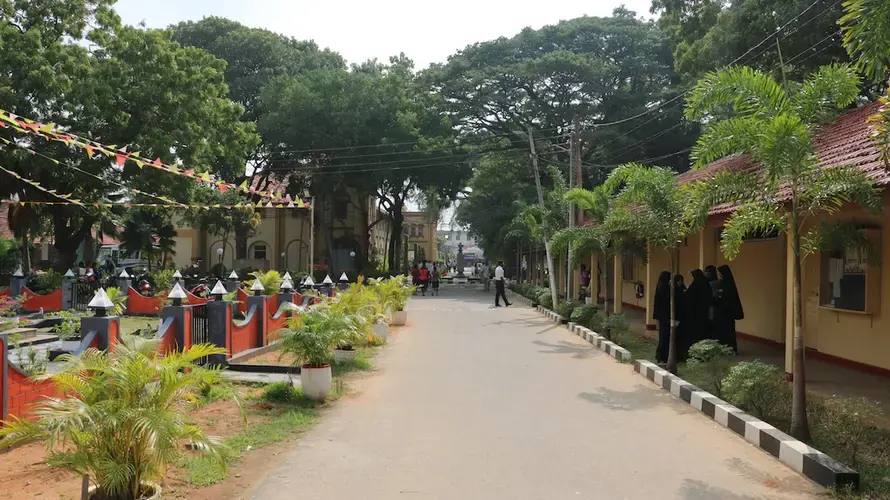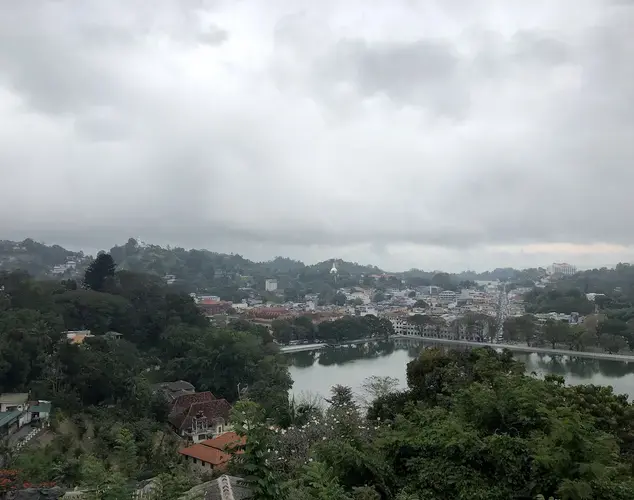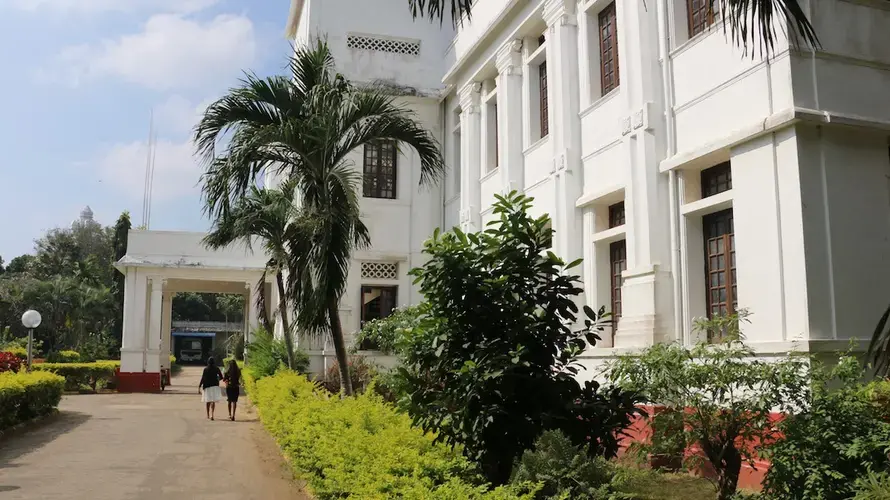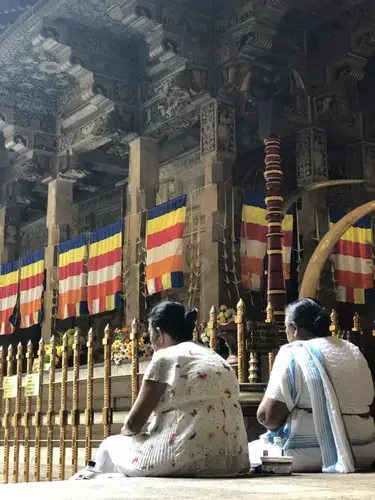
One day near the end of the Sri Lankan Civil War, while riding a bicycle to teachers college with her friends, Tharshini Kirusanthan saw the corpse of a young man. “The boy was nearly 21 years old, I think,” she says. “A dead body in front of our Hindu kovil.” She believes he’d been shot five or ten minutes before she spotted the body. “When we returned, the place was very normal. We were forced to forget everything.” In Jaffna, Sri Lanka, people are used to living without the freedom to remember, she says, to mourn.
When Tharshini speaks of the situation in Sri Lanka, she has wide eyes and a hard-set mouth. She smiles easily when she glances at her husband, Kirusanthan Sabaratnam. They sit beside one another as they speak of their families’ various displacements and the things they saw as children during the war, which lasted from 1983 to 2009. Traveling was difficult. Passes had to be sought both from the Sri Lankan army and the powerful Tamil separatist group, the Liberation Tigers of Tamil Eelam, or LTTE.

Throughout their childhood, the army often took people to camps during “round-ups,” Kirusanthan says. “After that, we get their dead bodies.” He pauses. “These are the day-to-day activities at that time.” Kirusanthan is a master’s student who commutes to Kandy, a city in the middle of the country, every weekend. He’s also a teacher and soon-to-be-father. They are expecting a son.
Sri Lanka has long piqued Western interest for its paradisiacal features—abundant natural resources, plentiful sunshine, post-card beaches—and geopolitical importance. As with so many modern “get-away” spots, tourists may visit the island while remaining unaware of its colonial history, or the civil war. Caught between the Sri Lankan army and the Tamil Tigers, thousands of Sri Lankans died and hundreds of thousands were displaced.
The tenth anniversary of the end of the war is in May. Many people have worked to bring the opposing sides of the conflict together over the last decade. Tharshini and Kirusanthan participated in one such effort: a program called Write to Reconcile, created in 2012 by the Sri Lankan-Canadian novelist Shyam Selvadurai. Selvadurai had previously been involved in a program that brought students from the north and south to the Galle Literary Festival, held most years in southern Sri Lanka. He wondered if it was possible to elevate dialogue about reconciliation to “another level,” and decided that creative writing would allow him to create a conducive space. The program, for him, was a great success. “I found that often it wasn’t so much what was said or did, but just the spirit of these people. It was—‘moving’ is the wrong word—it was interesting.”
Write to Reconcile sought to create mutual understanding across groups affected by the conflict. Seventy-four young people and a few teachers convened from every part of the island and from the diaspora. As a result, participants were able to make friends across ethnic and religious boundaries—sometimes for the first time. They were able to talk about the conflict with Sri Lankans who had experienced the worst of the war.
Write to Reconcile couldn’t achieve widespread results due to its small size, and the fact that it was conducted in English—a minority language in Sri Lanka. Long-lasting change would require politicians to back widespread structural reforms, improving access to education, stable employment, and housing. In the absence of this, the mothers of people disappeared during the war continue to protest. And ethno-religious strife continues, though on a much smaller scale. Early in 2018, anti-Muslim riots erupted, not the first time anti-Islamic prejudice had spurred violence on the island. Still, those who believe in peace work have carried it on.

Sri Lanka was at least partially controlled from 1505 to 1948 by the Portuguese, Dutch and then the British. In part due to this history, language is a sensitive topic in the country. Sri Lankan scholar Maryse Jayasuriya, in her book Terror and Reconciliation: Sri Lankan Anglophone Literature, 1983-2009, writes: “For one hundred and fifty years under British colonial rule, English was the only official language of administration, law, and business.” Directly following the departure of the British, the country was trilingual, with Sinhala, mostly spoken by the ethnic majority Sinhalese; Tamil, largely spoken by minority Tamils and Muslims; and English in use.
Though only spoken by the privileged few, English remained the language of bureaucracy in the years following independence. Some Tamils were highly proficient in English and, as such, were contenders for government jobs. Their linguistic competency facilitated what some Sinhalese considered to be disproportionate political representation of Tamils. It didn’t take long for politicians to realize they could seek “mass appeal by pandering to the preferences of the Sinhalese majority,” writes Jayasuriya, a majority that makes up about 70 percent of the population. This resulted in the Sinhala Only Act of 1956, which linguistically sidelined Tamils and other minorities.
In The Seasons of Trouble, a 2014 account of the civil war and its consequences, Rohini Mohan tells how one Tamil politician at the time said Tamils had been “tricked and betrayed,” calling the language policy “Sinhala colonisation.” But the rise in Sinhala nationalism wasn’t solely a reaction to the Tamil presence in government. Mohan writes that nationalistic sentiment “was initially a reaction to proselytising Christian missionaries and Westernisation.” The Sinhalese, feeling “threatened by British culture . . . set up more Buddhist vernacular schools and printed more Sinhala text books. Literature, mass media and political meetings all began to spread the message of Sinhalese superiority.”
Though only spoken by the privileged few, English remained the language of bureaucracy in the years following independence.
Scholars identify the Sinhala Only Act as pivotal in giving rise to the ethnic conflict; this perspective permeates fiction, too. One character in Akil Kumarasamy’s story collection Half Gods (2018) comments on the legislation’s effects. “In 1956 when Sinhala was declared the official language of the country, I decided not to attend university. I had once dreamt of translating Tamil texts into English, and in the end it was language that kept me from that dream.”
On paper, now, Sri Lanka is again officially trilingual, but there are still accessibility issues due to uneven implementation of the policy and poor-quality translations. Tamils trying to register the birth of a child, for instance, may be given a form in Sinhala, which many would be unable to understand without help.
Literature in English, while it remains problematically inaccessible to many Sri Lankans, is one vehicle for sharing conciliatory narratives, cultivating a non-nationalistic awareness of socio-cultural problems, and promoting healing. Jayasuriya writes that “Sri Lankan English language literature is crucial as a medium for dialogue and reconciliation.” Kumarasamy told Poets & Writers that the English language “is currency,” and the popular Sri Lankan writer, Ashok Ferrey, calls English “the language of peace.”
Write to Reconcile wouldn’t have been possible without English. The program was active from 2012 to 2017, and three anthologies of student work have been published. Writing about the experiences of minorities in a language that some in the majority—and an international audience—can comprehend might enable understanding.
Thulasi Muttulingam, a freelance journalist based in Jaffna, shares the same goal, writing about northern Sri Lankans for a mostly foreign audience. When we met, she told me about the events that precipitated the war. “It started right here in this part of town,” she says, sitting in an outbuilding of her childhood home in Jaffna. In 1983, the Tigers attacked an army truck and 13 young soldiers died; in response, Sinhalese mobs burned Tamil businesses and homes, killing hundreds of people. “A lot of people were shot in this vicinity,” Thulasi says. “I have quite a few relatives who were murdered.” Thulasi grew up in the Maldives, where her family relocated after the riots. She moved back to her birth-country as an adult. One consequence of immigrating is Thulasi’s comfort with English. She spoke it growing up and has used it to communicate problems in Sri Lanka to an outside, mostly unaware world.
Earlier events precipitated some families’ exodus from the country. In 1981, the Jaffna library—then one of the largest in South Asia—was burned down by a Sinhalese mob in retaliation for the deaths of three Sinhalese policemen killed during a rally. The library’s destruction was an enormous loss to Tamils everywhere. According to reports, 97,000 items were destroyed including many irreplaceable manuscripts.
Nalini Sivathasan participated in Write to Reconcile’s second year. Her father had seen Jaffna’s library burn from the hospital where he was then a medical student. Shortly after, he decided it was time to leave Sri Lanka. He and his wife immigrated to London, where Nalini was born and grew up. Meeting Sinhalese people—a community she hadn’t encountered in England—during Write to Reconcile gave her a new perspective, even if she didn’t always agree with what they said. “The writing process and listening to people’s stories” made her more empathetic to those on “the other side,” she says.

For many, being a diaspora kid means longing to understand what has been left behind while also feeling alienated from the only place experienced as “home.” Rather than trying to convey to an outside world what was happening locally, Nalini became a reporter, in part, to “gain awareness [of] Tamil issues.” She is now a multimedia journalist for the BBC’s Asian Network. “I think you’re in dangerous territory when you’re only publishing stuff which you agree with,” she tells me, sitting in her parents’ home in a London suburb. She recalls a story she’d done on a Tamil filmmaker whose work is critical of the LTTE. She doesn’t personally agree with much of what the filmmaker has to say and faced criticism from friends and others in the Tamil community for giving him the “oxygen of publicity.” But, she says, “he deserves to be heard. His voice—it’s creating a dialogue which is really important.”
This was one of the goals for Write to Reconcile: to create dialogue among young people whose experiences of the conflict varied widely, depending on their ethnicity, location, language, and socio-economic standing. What reconciliation work requires from each person is likewise varied. For Nalini it is trying to understand—and give voice to—the many different perspectives behind a conflict that caused her family’s displacement. It involves engaging with literature from all parts of Sri Lanka and learning about analogous situations—she points to the Israel-Palestine conflict and the Troubles in Ireland. For others in the program, reconciliation means taking the first step to talk with people from other, differently affected groups; to counsel those suffering from mental illness; to take up legal studies or teach literature.
Eesha Coswatte, who participated during Write to Reconcile’s final year, has something to say about seemingly every political issue in her country, and often speaks out about everything from menstrual stigmas to her experiences with gender-based violence, sexual harassment and assault.
Both of Eesha’s parents have served long tenures in the Sri Lankan Army. She has asked them hard questions about the war—if rape and genocide happened, for instance. “They don’t deny the sexual violence,” she says, but neither do they accept the allegation of genocide. Only a certain amount of people “can think objectively,” about the war, Eesha says—those who have been educated and can acknowledge wrongdoing on both sides. Though her parents were active participants in the majority side of the conflict, she says her grandparents sheltered the only Tamil in their town when the war first began, and she and her family have lived in Jaffna for multiple month-long stints.
During the Write to Reconcile workshop, Eesha wrote poems that describe the PTSD of returning soldiers, social rehabilitation of ex-Tamil Tigers, and the societal repercussions of forced sex work. Her presence is like her poetry—strong but not forceful; there’s a hint of sarcasm in her smile. With her poems, she wishes to shock people into listening to stories they might otherwise reflexively turn away from.
Eesha felt her co-participants were able to hear her and called the workshop a “holistic experience” through which her perceptions were changed. Concurrently, students were also “learning about language and how to write,” she says.
Many participants were moved by the writing of their peers. Nalini said her own perceptions were changed by reading the work of Ranmini Gunawardena, an English teacher who took part in the same year. “As a Tamil, when you think of the army, you think of like—they’re the enemy, kind of thing,” Nalini says. “That’s what they’re seen as, as the people who committed all these abuses. But her brother got killed.” Ranmini’s brother was a pilot in the Sri Lankan air force and was killed by the Tamil Tigers. “She wrote a story about him, and it was really poignant. I didn’t think that I would have that much sympathy for her brother,” Nalini says. “I didn’t agree with what he was fighting for, but I could understand her loss and what he was like as a brother and a human.”
Though Eesha’s parents were active participants in the majority side of the conflict, she says her grandparents sheltered the only Tamil in their town when the war first began.
As for Ranmini, she credits Selvadurai for making her a writer. Since participating in 2014, she has continued to write. She used what she learned to develop a workshop of her own and has published two anthologies of her students’ poetry. After Write to Reconcile, Ranmini knew that “it wasn’t only me who suffered; the Tamil suffering was greater.” She went on: “There are no victors in war; we are all victims.”
The effects of conflict on mental and physical health are wide-ranging and take generations to fully manifest. Lasting reconciliation will likely also take generations of people dedicated to peace work—which is more than simply maintaining an absence of war. In the nearly ten years since the end of the armed conflict, survivors have faced many obstacles to resuming “normal” life—long-standing displacement both internally and externally, loss of land and possessions, lack of mental health resources, and lack of information regarding the thousands of people “disappeared” during the war and the years immediately following. (The Human Rights Data Analysis Group estimates that as many as 503 people were forcibly disappeared during the final three days of the war alone. Over the course of the war, the number runs into the tens of thousands.)

Though Tamils’ troubles in Sri Lanka continue, recent events point to a shift in focus for violent Sinhalese-Buddhist nationalists, and a developing crisis for Sri Lankan Muslims. Muslims weren’t exempt from the effects of the conflict—the LTTE expelled tens of thousands of Muslim families from the areas under their control, and scores remained internally displaced as a result. Militant Buddhists have sporadically targeted Muslim communities as well. There were anti-Muslim riots in 2014 and 2018. During the war, in 2001, this violence cost Wazna Wazeer and her family their home. “My house—it was completely burned,” she says. “When I looked up at the house, I could see nothing. I could see the sky and the trees over. Everything was bare.” They lost their furniture, clothes, school supplies, the outbuilding where her father conducted his business. “It was really hard to rebuild the house,” she recalls. “And my father, he also was not that established in his business and he had four kids to feed.” Though this happened nearly 18 years ago, the family has not felt safe in their country since then.
Wazna wants to become a professor, though her dream has been deferred since she withdrew from her degree program last year due to security concerns. “I feel now the time is really unsafe for Muslims,” Wazna says, sitting in her uncle’s living room. Just outside are the dwellings of other family members and the family’s ancestral home. When the riots erupted again last year, it was here that Wazna and her female family members fled. “How many times are we going to face the same thing over and over again?” she remembers her parents asking. Muslim-owned shops and houses stand beside mosques, restaurants and roadside stands along the winding thoroughfare between Kandy, where she lives, and Colombo. Her uncle’s house is nestled in the family compound, away from the road, and safer; her parents’ land is exposed.
The issue between Tamils and Sinhalese is “seemingly over,” Wazna says, but “because this is a predominantly Buddhist country, there are some extremists who prefer that this is a Buddhist land and that only Buddhists should live here.” At the Write to Reconcile workshop Wazna attended in 2014, she didn’t feel this threat. It was clear to her that Selvadurai was culturally sensitive. For example, he knew not to shake her hand. When asked whether it was difficult for her to participate alongside Sinhala Buddhists, Wazna says she had preconceived notions about what people from different groups would be like, but that these were changed during the workshop. “Whatever misunderstandings and wrong judgments I had,” she says, “all got erased because of the program.”
Lilani Anuruddhika Dias Weerasinghe, who is from southern Sri Lanka, participated in the program alongside Wazna and the two became good friends. “I don’t think the war is actually over,” Lilani says. Though there is no active warfare, some people are still in a mental warzone. If efforts to bring people together stop, the conflict could again break out. For Lilani, reconciliation is not just a healing process but a preventative tool.
“After Write to Reconcile, I realized war affected everyone, whether young or old, even if you were living in Sri Lanka, even if you have left the country,” she says. “If we are to prevent something like that from happening again, I think we have to discuss things. We can’t just keep things to ourselves.” As a member of the majority Sinhalese population and as someone who didn’t have the “heavier experiences” of the war, Lilani feels it’s important for her to try to connect with others and show her support for the minority. She doesn’t want another war.
“That’s why I need to keep continuing the work.”








